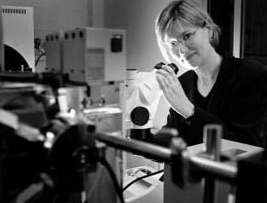Sylvie Doublié, Ph.D.

- Title
- Professor
- Department
- Department of Microbiology and Molecular Genetics
- Institution
- University of Vermont
- Address
-
E314A Given Building
89 Beaumont Avenue - City, State, ZIP
- Burlington, VT 5405
- Phone
- (802) 656-9531
- [email protected]
- Website
- http://www.uvm.edu/microbiology/directory/mmg-faculty-directory/faculty-details/?people_id=89

- Research field
- Structural Biology
- Award year
- 2000
Research
The major thrust of my research program is to study modifications in DNA or RNA in the context of the enzymes and proteins that generate and recognize them. Researchers in my lab are pursuing three general areas of investigation. 1) DNA polymerases, which otherwise faithfully replicate DNA, stumble when they encounter oxidative DNA lesions. Polymerases either will be blocked at the site of lesion, or bypass it. The latter case, referred to as translesion synthesis, may initiate an oncogenic process if the wrong base is inserted opposite the lesion. One aim is focused on uncovering the fundamental mechanisms underpinning translesion synthesis, which is paramount to understanding the initial events of mutagenesis. A second aim of the lab is studying Base Excision Repair (BER). Several DNA repair mechanisms are in place to minimize damage in DNA before DNA polymerases replicate the genome. One of these processes is called Base Excision Repair (BER). The goal of this project is to delineate the structural features of the DNA glycosylases that are involved in recognition of DNA base damage produced by ionizing radiation. Lastly, we are investigating Messenger RNA (mRNA) modifications. During processing of the 3’-end of mRNA, an endonucleolytic cleavage event precedes the addition of a poly(A) tail. Such maturation of 3’-ends is a key regulatory step in the expression of many genes. The cleavage and polyadenylation reactions are carried out by a multicomponent machinery of remarkable complexity. Our goal is to understand how the different components of the machinery interact to cleave then polyadenylate messenger RNAs.
Scholar Keywords
2000 Search Pew Scholars
- Michael J. Berry II, Ph.D.
- Sylvie Doublié, Ph.D.
- Mark D. Fleming, M.D., D.Phil.
- Barbara L. Golden, Ph.D.
- Bob Goldstein, Ph.D.
- Dorit Hanein, Ph.D.
- Jay D. Horton, M.D.
- Dean H. Kedes, M.D., Ph.D.
- Caroline F. Kisker, Ph.D.
- Qiufu Ma, Ph.D.
- Pamela B. Meluh, Ph.D.
- R. Dyche Mullins, Ph.D.
- Venkatesh N. Murthy, Ph.D.
- George A. O'Toole, Ph.D.
- David J. Sullivan, M.D.
- Lise R. Thomas, Ph.D.
- Mark B. Van Doren, Ph.D.
- Thomas E. Wilson, M.D., Ph.D.
- Hao Wu, Ph.D.
- Phillip D. Zamore, Ph.D.